 Trudvang Legends was one of my most anticipated games of 2022 as well as one of the most overdue crowdfunded games. CMON even gave everyone free split-wave shipping so they could ship the core box out before the rest of the content was done. As I chronicled here the game went through significant changes post-campaign to the point where many backers, myself included, were questioning if the final product was going to be what they thought they backed.
Trudvang Legends was one of my most anticipated games of 2022 as well as one of the most overdue crowdfunded games. CMON even gave everyone free split-wave shipping so they could ship the core box out before the rest of the content was done. As I chronicled here the game went through significant changes post-campaign to the point where many backers, myself included, were questioning if the final product was going to be what they thought they backed.
This was also a title where Tony was glad he dropped his pledge and I was nervously excited to receive my copy. Was it worth the wait? Who gets to claim to be right and give the other one a smug look at the next BGQ BBQ? Turn to Gameplay Overview to continue…
Gameplay Overview:
Once the board is set up per the Book of Sagas you’ll move around the map following the steps in the Phases area. Considering you start at step two, I’m assuming this will change at some point during the campaign. You’ll also fill your rune bag per your character card and based on any extra cards you have that grant extra runes. Runes earned during a scenario generally reset at the start of the next scenario.
There are two main types of activities that you’ll do throughout the game. The first is a Test. These will show one of the runes and then a number indicating you need that many successes. Then you draw seven runes and see if you succeed.
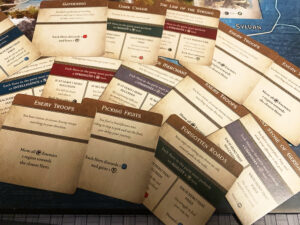
Combat is a little more involved and has you drawing four of your eight (or so) Feat cards and then drawing runes, three at a time, and placing them on these cards. Any rune that doesn’t match one of the symbols on your cards or a dark rune go on the failure track. Continue drawing until you have five failures or you choose to stop drawing. If you stop drawing before you’ve drawn four failures, you gain all the blue tokens shown on the miss track. A fifth rune triggers a failure condition and all the red tokens on the miss track are activated. As you gain these combat runes, they’ll push older runes off giving you a path to improve your successes and lessen your defeats.
After you stop drawing runes you activate each ability. Skills get activated first along with fast attacks. Then the enemies go drawing a card and adjusting their attack value up or down by the amount indicated. They also will sometimes activate a secondary ability based on a symbol on some of the cards. Some feats grant chronicle points which can be used to activate secondary effects on other cards or spent at locations for benefits.
After the enemies, the heroes get to use their attacks. If both sides are still standing, you go to the next phase. You can have another battle in a future turn or you could nope out of combat and take some damage on your way out.
You gain an experience point if you defeat your opponents. After gaining three experience points, you can draw three cards from a deck of improved feats and pick one that replaces a lower level of that same ability.
Continue running around the board making skill checks and battling foes until you complete the scenario. Throughout the story you’ll advance the narrative by reading sections of the Book of Saga adding cards to the board as well as title cards based on your actions. Many locations on the map offer bonuses for providing actions.
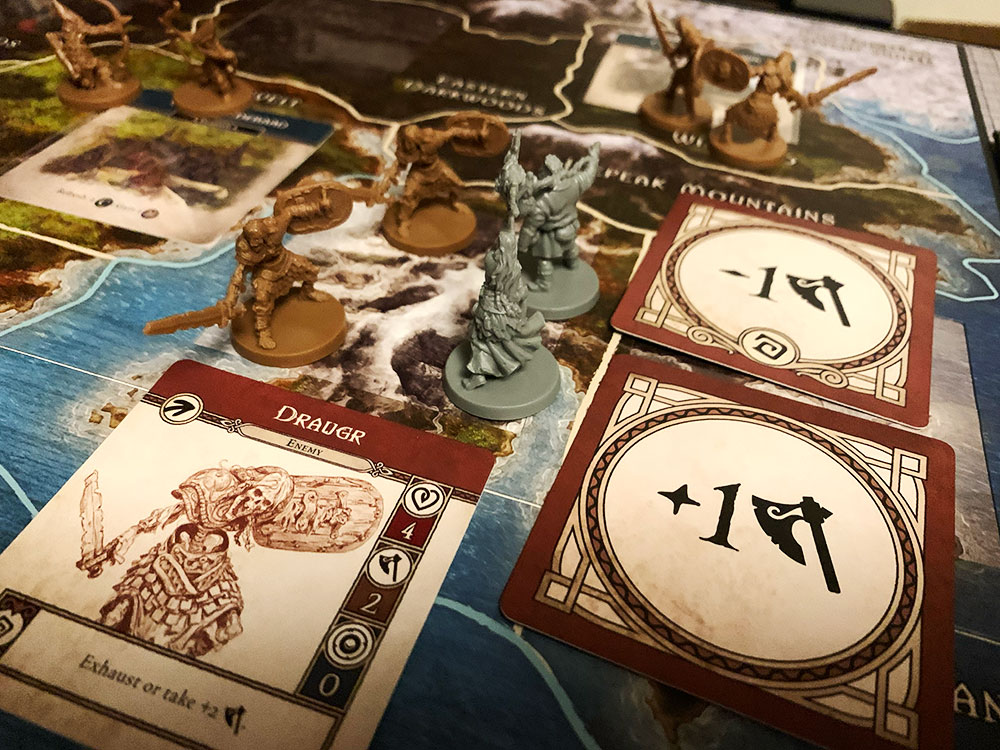
Game Experience:
One of the most novel things about this game during the campaign was the board that has pockets to hold cards that allow the world to continually update throughout the campaign. The rune draw mechanism seemed like a simple and engaging combat system for a game that wasn’t all about combat, much like Roll Player Adventures and Solomon Kane.
The story and world are engaging. The writing is fairly good and each part you read covers a few short paragraphs which is enough to give some flavor without turning into a bedtime story across eight pages of text. As a huge positive through the first part of the story that I played there appeared to be plenty of branches where your player choices open up different quests and different allies or enemies. I’m sure some of these are different hallways to the same room but it’s not as on-rails as some other adventure games. I also liked how certain classes being present granted automatic successes or opened different areas of the story which will add to the replayability.
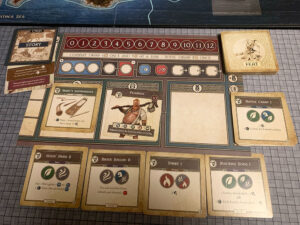
The gameplay loop of drawing runes is fine and the hit/miss track works fairly well but felt too repetitive after a few scenarios. Leveling up feats is cool but happens at a snail’s pace with slightly better versions of your skills. Generally, runes you gain during a scenario go back to the supply at the start of the next scenario which removes that bag building aspect to the game or adds a layer of grind as you run around each story to re-bolster your bag of cardboard chits.
Spending entire turns not being able to make progress in combat because I didn’t draw an attack card was underwhelming. And while that’s annoying and does slow the game down, what negatively affected my enjoyment of the game was what happened when you die in combat; essentially nothing. Come back to life with 6 health and gain a negative Wyrd card. When you draw a Wyrd card as one of your four feats for a round of combat you can try to complete it which removes it from the game. If you fail to remove the card by the end of the scenario there’s some minor consequence (I haven’t finished the campaign so maybe these stack into a bigger negative). I do appreciate a fail forward design, especially in a narrative based game but the seeming lack of consequence, coupled with a mediocre system really sucked the life out of the game. But with limited healing around, you will likely pick up this extra busy work task.
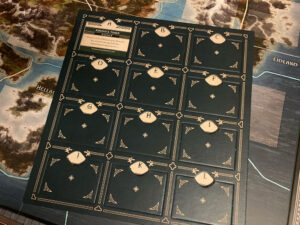
However, the underbaked combat system was weirdly still more enjoyable than skill checks. I think my heartache is the required number of successes. Requiring four water runes when only one character may have four in their bag of 15 or so runes gives a very small chance of success (between 0.2 and 0.7% chance if I did the math right). I would routinely encounter a skill test, check my character card, and then go straight to the fail section to save myself the time of pulling runes when I couldn’t possibly succeed. I don’t think I ever passed a skill check requiring four successes in five scenarios and maybe two that required three successes out of twenty or more checks.
Final Thoughts:
I was enthralled by the art and the lore pulled me in. But after a handful of plays, I realized I might as well just be reading a choose-your-own-adventure story and skip all the mechanics which weren’t engaging. And it bothers me to write it, and not just because Tony gets to gloat (but that too), it’s because a group of people spent a lot of effort on something and, in my opinion, it just doesn’t work. CMON bought the Trudvang IP from Riotminds so this seems to be something they’re investing in. And while I like it more than NFT’s, that’s a pretty low bar to clear.
Final Score: 2 Stars – Bland and underwhelming game mechanics surround an interesting collection of ideas and an engaging narrative.
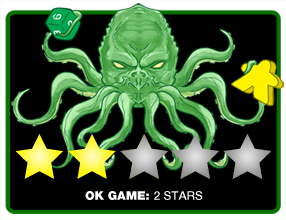 Hits:
Hits:
• Engaging Narrative
• World changes through your actions
• Cool minis
Misses:
• Combat is boring
• Passing skill checks is very unlikely
• Leveling up is slow and uninteresting






















The last years, i saw games with an overkill of boards, scales, cards and so on.
Maybe this is the reason i skip all those games and put the old Viktory II on the table. A gane straight to the point. I miss those games today.
It seems, if your game is not overwhelming with stuff, you can’t sell it on Kickstarter.
This game definitely was a typical CMON providing a ton of stuff. The game could’ve done away with minis for tokens, standees or meeples and it would’ve been the same. But you’re right – the piles of plastic is what often draws the big money.
And while I’ve fallen for some of these big campaigns in the past I’m becoming more discerning about making sure there’s some substance to go with the bling.